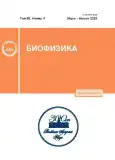Influence of the microenvironment dynamics of tryptophan on its fluorescence parameters at different temperatures
- Авторлар: Gorokhov V.V1, Knox P.P1, Korvatovsky B.N1, Goryachev S.N1, Paschenko V.Z1, Rubin A.B1
-
Мекемелер:
- Lomonosov Moscow State University
- Шығарылым: Том 68, № 4 (2023)
- Беттер: 629-639
- Бөлім: Articles
- URL: https://journals.rcsi.science/0006-3029/article/view/142115
- DOI: https://doi.org/10.31857/S0006302923040014
- EDN: https://elibrary.ru/KIKARV
- ID: 142115
Дәйексөз келтіру
Толық мәтін
Аннотация
Негізгі сөздер
Авторлар туралы
V. Gorokhov
Lomonosov Moscow State UniversityMoscow, Russia
P. Knox
Lomonosov Moscow State UniversityMoscow, Russia
B. Korvatovsky
Lomonosov Moscow State UniversityMoscow, Russia
S. Goryachev
Lomonosov Moscow State UniversityMoscow, Russia
V. Paschenko
Lomonosov Moscow State University
Email: vz.paschenko@gmail.com
Moscow, Russia
A. Rubin
Lomonosov Moscow State UniversityMoscow, Russia
Әдебиет тізімі
- J. L.Dashnau, B. Zelent, and J. M. Vanderkooi, Biophys. Chem., 114, 71 (2005).
- D. E. Schlamadinger, J. E. Gable, and J. E. Kim, J. Phys. Chem. B, 113, 14769 (2009).
- Э. А. Бурштейн, Молекуляр. биология, 17, 455 (1983).
- A. G. Szabo and D. M. Rayner, J. Am. Chem. Soc., 102, 554 (1980).
- J. R. Lakowicz, Principles of fluorescence spectroscopy, 3nd ed. (Springer, New York, 2006).
- P. D. Adams, Y. Chen, K. Ma et al., J. Am. Chem. Soc., 124, 9278 (2002).
- J. A. Ross and D. M. Jameson, Photochem. Photobiol. Sci., 7, 1301 (2008).
- P. P. Knox, E. P. Lukashev, V. V. Gorokhov, et al., J. Photochem. Photobiol. B: Biology, 189, 145 (2018).
- P. P. Knox, V. V. Gorokhov, B. N. Korvatovsky, et al. J. Photochem. Photobiol. A: Chemistry, 393, 112435 (2020).
- В. В. Горохов, Б. Н. Корватовский, П. П. Нокс и др., Докл. РАН. Науки о жизни, 498, 19 (2021).
- В. З. Пащенко, В. В. Горохов, Б. Н. Корватовский и др., Биофизика, 66, 354 (2021).
- J. Pieper, Th. Hauss, A. Buchsteiner, et al., Biochemistry, 46, 11398 (2007).
- W. Doster, Eur. Biophys., J. 37, 591 (2008).
- K. L. Han and G. J. Zhao, Hydrogen Bonding and Transfer in the Excited State (John Wiley & Sons Ltd., Chichester, UK, 2011).
- H. Liu, H. Zhang, and B. Jin. Spectrochim. Acta. Part A: Molecular and Biomolecular Spectroscopy, 106, 54 (2013).
- Р. Блинц и Б. Жекш, Сегнетоэлектрики и антисегнетоэлектрики. Динамика решетки (Мир, М., 1975).
- K. Vandewal, Annu. Rev. Phys. Chem., 67, 113 (2016).
- M. G. Muller, K. Griebenow, and A. R. Holzwarth, Chem. Phys. Lett., 199, 465 (1992).
- Y. Miloslavina, M. Szczepaniak, M. G. Muller, et al. Biochemistry, 45, 2436 (2006).
- R. A. Marcus and N. Sutin, Biochim. Biophys. Acta, 811, 265 (1985).
- P. M. Krasilnikov, P. P. Knox, and A. B.Rubin, Photochem. Photobiol. Sci., 8, 181 (2009).
- А. Б. Рубин, Биофизика (М., 2013), т. 3.
- В. И. Лобышев, Б. Д. Рыжиков и Р. Э. Шихлинская, Биофизика, 43 (4), 710 (1998).
- S. Pershin and A. Bunkin, Laser Physics, 19, 1410 (2009). DOI: 10.1134/ S1054660X0907007X
- K. B. Jinesh and J. W. M. Frenken, Appl. Phys. Lett., 101, 036101 (2008).
- J. Davis, K. Gierszal, P. Wang, and D. Ben-Amotz, Nature, 491, 582 (2012). doi: 10.1038/nature11570
Қосымша файлдар









